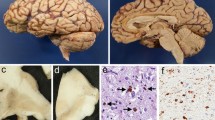Opinion statement
Corticobasal degeneration (CBD) is a neurodegenerative disorder characterized clinically by a combination of cortical and basal ganglia signs. Pathologically, it is classified as a tauopathy. The most distinctive clinical feature is its unilateral or markedly asymmetric presentation; among parkinsonian syndromes, with rare exceptions, only Parkinson’s disease presents with such asymmetry. The most common presenting cortical features include apraxia (patients often complain of a “useless” limb), aphasia (usually nonfluent), parietal lobe sensory signs (agraphesthesia, extinction, astereognosis), frontal dementia, or myoclonus. Basal ganglia signs include rigidity, akinesia, limb dystonia, and postural instability.
The diagnosis is often challenging for three reasons: 1) The full complement of findings are rarely seen at presentation; 2) If CBD is not suspected, subtle but relevant findings (eg, extinction, language impairment, myoclonus, or apraxia) may not be searched for or appreciated; 3) The clinical picture of CBD has substantial overlap with a variety of other parkinsonian and dementing illnesses. The differential diagnosis includes Parkinson’s disease, progressive supranuclear palsy, frontotemporal dementia, primary progressive aphasia, and Alzheimer’s disease. The clinical diagnosis is not confirmed pathologically in up to half of cases, so the term corticobasal syndrome is often preferred during life, reserving the term corticobasal degeneration for pathologically verified cases.
Treatment of CBD is primarily supportive, and most patients die within 10 years of onset. Parkinsonian signs may improve to a modest degree with levodopa, clonaze pam can suppress myoclonus, and botulinum toxin can relieve dystonia. Early speech therapy, physical therapy, and occupational therapy, as well as assist devices such as a rolling walker may improve functioning and reduce complications such as aspiration pneumonia and falls. With time, however, most patients lose their independence and mobility. Throughout the course of the illness (particularly when it is advanced), caring for the caregiver is as important as caring for the patient.
Similar content being viewed by others
References and Recommended Reading
Mahapatra RK, Edwards MJ, Schott JM, et al.: Corticobasal degeneration. Lancet Neurol 2004, 3:736–743.
Wadia PM, Lang AE: The many faces of corticobasal degeneration. Parkinsonism Relat Disord 2007, 13(Suppl 3):S336–S340.
Lang AE: Corticobasal degeneration: selected developments. Mov Disord 2003, 18(Suppl 6):S51–S56.
Boeve BF, Lang AE, Litvan I: Corticobasal degeneration and its relationship to progressive supranuclear palsy and frontotemporal dementia. Ann Neurol 2003, 54(Suppl 5):S15–S19.
Dickson DW, Bergeron C, Chinn SS, et al.: Office of Rare Diseases neuropathologic criteria for corticobasal degeneration. J Neuropathol Exp Neurol 2002, 61:935–946.
Arvanitakis Z, Wszolek ZK: Recent advances in the understanding of tau protein and movement disorders. Curr Opin Neurol 2001, 14:491–497.
Dickson DWJ: Neuropathologic differentiation of progressive supranuclear palsy and corticobasal degeneration. J Neurol 1999, 246(Suppl 2):6–15.
Josephs KA, Petersen RC, Knopman DS, et al.: Clinicopathologic analysis of frontotemporal and corticobasal degenerations and PSP. Neurology 2006, 66:41–48.
Litvan I, Grimes DA, Lang AE: Phenotypes and prognosis: clinicopathologic studies of corticobasal degeneration. Adv Neurol 2000, 82:183–196.
Litvan I, Grimes DA, Lang AE, et al.: Clinical features differentiating patients with postmortem confirmed progressive supranuclear palsy and corticobasal degeneration. J Neurol 1999, 246(Suppl 2):II1–II5.
Rebeiz JJ, Kolodny EH, Richardson EP: Corticodentatonigral degeneration with neuronal achromasia. Arch Neurol 1968, 18:20–33.
Riley DE, Lang AE, Lewis A, et al.: Cortical-basal ganglionic degeneration. Neurology 1990, 40:1203–1212.
Togasaki DM, Tanner CM: Epidemiologic aspects. Adv Neurol 2000, 82:53–59.
Wenning GK, Litvan I, Jankovic J, et al.: Natural history and survival of 14 patients with corticobasal degeneration confirmed at postmortem examination. J Neurol Neurosurg Psychiatry 1998, 64:184–189.
Thompson PD: Myoclonus in corticobasal degeneration. Clin Neurosci 1995–1996, 3:203–208.
Thompson PD, Day BL, Rothwell JC, et al.: The myoclonus in corticobasal degeneration. Evidence for two forms of cortical reflex myoclonus. Brain 1994, 117:1197–1207.
Doody RS, Jankovic J: The alien hand and related signs. J Neurol Neurosurg Psychiatry 1992, 55:806–810.
Rinne JO, Lee MS, Thompson PD, et al.: Corticobasal degeneration. A clinical study of 36 cases. Brain 1994, 117:1183–1196.
Kompoliti K, Goetz CG, Boeve BF, et al.: Clinical presentation and pharmacological therapy in corticobasal degeneration. Arch Neurol 1998, 55:957–961.
Vidailhet M, Rivaud S, Gouider-Khouja N, et al.: Eye movements in parkinsonian syndromes. Ann Neurol 1994, 35:420–426.
Garbutt S, Riley DE, Kumar AN, et al.: Abnormalities of optokinetic nystagmus in progressive supranuclear palsy. J Neurol Neurosurg Psychiatry 2004, 75:1386–1394.
Graham NL, Bak TH, Hodges JR: Corticobasal degeneration as a cognitive disorder. Mov Disord 2003, 18:1224–1232.
Grimes DA, Lang AE, Bergeron CB: Dementia as the most common presentation of cortical-basal ganglionic degeneration. Neurology 1999, 53:1969–1974.
McKhann GM, Albert MS, Grossman M, et al.: Clinical and pathological diagnosis of frontotemporal dementia. Arch Neurol 2001, 58:1803–1809.
Graham NL, Bak T, Patterson K, et al.: Language function and dysfunction in corticobasal degeneration. Neurology 2003, 61:493–499.
Murray R, Neumann M, Forman MS, et al.: Cognitive and motor assessment in autopsy-proven corticobasal degeneration. Neurology 2007, 68:1274–1283.
Hossain AK, Murata Y, Zhang L, et al.: Brain perfusion SPECT in patients with corticobasal degeneration: analysis using statistical parametric mapping. Mov Disord 2003, 18:697–703.
Soliveri P, Monza D, Paridi D, et al.: Cognitive and magnetic resonance imaging aspects of corticobasal degeneration and progressive supranuclear palsy. Neurology 1999, 53:502–507.
Koyama M, Yagishita A, Nakata Y, et al.: Imaging of corticobasal degeneration syndrome. Neuroradiology 2007, 49:905–912.
Constantinescu R, Richard I, Kurlan R: Levodopa responsiveness in disorders with parkinsonism: a review of the literature. Mov Disord 2007, 22:2141–2148.
Frucht S, Fahn S, Chin S, et al.: Levodopa-induced dyskinesias in autopsy-proven cortico-basal ganglionic degeneration. Mov Disord 2000, 15:340–343.
Vanek ZF, Jankovic J: Dystonia in corticobasal degeneration. 2000, 82:61–67.
Cordivari C, Misra VP, Catania S, et al.: Treatment of dystonic clenched fist with botulinum toxin. Mov Disord 2001, 16:907–913.
Wielinski CL, Erickson-Davis C, Wichmann R, et al.: Falls and injuries resulting from falls among patients with Parkinson’s disease and other parkinsonian syndromes. Mov Disord 2005, 20:410–415.
Author information
Authors and Affiliations
Corresponding author
Rights and permissions
About this article
Cite this article
Reich, S.G., Grill, S.E. Corticobasal degeneration. Curr Treat Options Neurol 11, 179–185 (2009). https://doi.org/10.1007/s11940-009-0021-9
Published:
Issue Date:
DOI: https://doi.org/10.1007/s11940-009-0021-9




